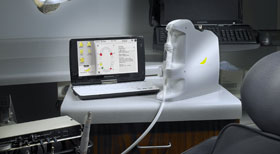Detecting & healing tooth decay
Tooth decay is a prevalent disease worldwide. According to the US Surgeon General Report, tooth decay is one of the most common chronic diseases among 5 - 17 year olds, more common than asthma, hay fever or chronic bronchitis. It is responsible for large numbers of days off school and work. The traditional treatment for tooth decay is to wait until a large cavity develops, remove decay and then place a filling.

If tooth decay is detected early, before a substantial amount of the tooth is destroyed, the area can be remineralized by using fluorides and other remineralizing agents. The current diagnostic tools and techniques are not sensitive enough to detect these early areas of decay or to monitor their ongoing progression. The Canary System™ allows oral health providers to detect and monitor tooth decay on all surfaces of the tooth and then to use this information to design preventive based dental programs to heal or remineralize these areas without using invasive techniques. For patients it means safe, easy dental appointments.
For dentists it provides a new preventive program in their offices with a new revenue stream. For employers, early detection and prevention saves long term down-stream costs associated with large fillings, root canals, extractions etc. Let's take a look at how one can detect and heal tooth decay.
Caries: Tools for enhancing the prevention and management of a common oral disease. By Dr Stephen Abrams. Dentistry IQ. March, 2018.
View PDF
Is there room for laser-based caries detection in dental hygiene practice? By Julie DiNardo, RDH. Dentistry IQ. March, 2016.
View PDF
Implementing CAMBRA in the private practice: A clinical report. By Dr. Pamela Maragliano-Muniz, DMD and Diane Proudy, RDH. Dentistry IQ. May, 2015.
View PDF
Overcoming a clinical challenge: detecting caries around amalgam restorations. Dentistry Today, January 2015.
View PDF
Is it time to change our approach to caries management? Feb 2015. CDA Essentials.
View PDF
Detecting Caries at Restoration Margins. By Dr Stephen Abrams, DDS. Oral Health, July 2014.
View PDF
Do We Really Need Caries Detection Devices? By Dr Stephen Abrams, DDS. Dental Teamwork, March 2014.
View PDF
Improving the way to detect cracks in teeth. By Dr Stephen Abrams, DDS. Dentistry Today, July 2013.
View PDF
Using The Canary System to develop a caries management program for children. By Dr Stephen Abrams, DDS. Dental Teamwork. Vol 6-No.3. March 2013.
View PDF
Remineralization of Carious Lesions - It really does work! By Dr Stephen Abrams, DDS. December 2012. Oral Health.
View PDF
Overcoming the challenges of caries detection using The Canary System. By Dr Stephen Abrams, DDS. Oral Health. December 2011.
View PDF
Healing Dental Caries. By Dr Stephen Abrams, DDS. Oral Health, December 2010.
View PDFHarnessing light and energy for the early detection of dental caries. By Dr Stephen Abrams, DDS. Oral Health, December 2009.
View PDFEmerging technologies for diagnosis of dental caries: The road so far. By Amaechi B.T. Journal of Applied Physics. 2009:105(102047)
View PDF Early detection and remineralization: A new approach to treating tooth decay using The Canary System™. Canary Update. By Dr Stephen Abrams, DDS. November 2009.
View PDFDental and remineralization: Does it really work? Canary Update. By Dr Stephen Abrams, DDS. November 2008.
View PDFEarly caries detection: an evolution in the way we diagnose and treat dental caries. By Dr Stephen Abrams, DDS. Canadian Journal of Cosmetic Dentistry, 2007.
View PDFFocus on dental caries management - beyond extension for prevention to minimal intervention. By Abrams S., Scarlett MI, and Trost L. Oral Health, March 2006.
View PDFNew approaches to diagnosis, management, and treatment of dental caries. By Dr Stephen Abrams, DDS. Oral Health, March 2004.
View PDF
